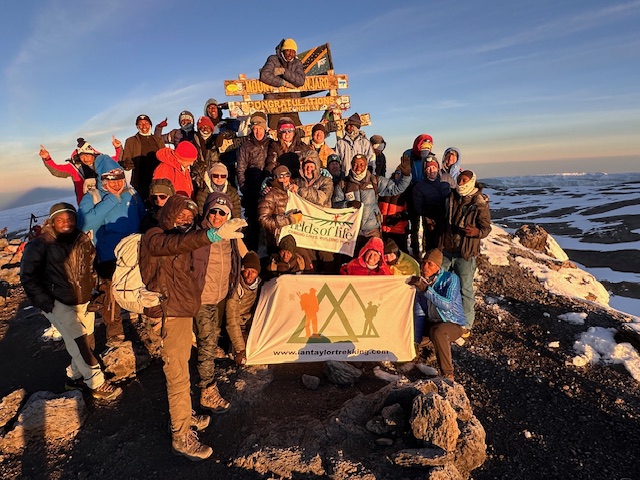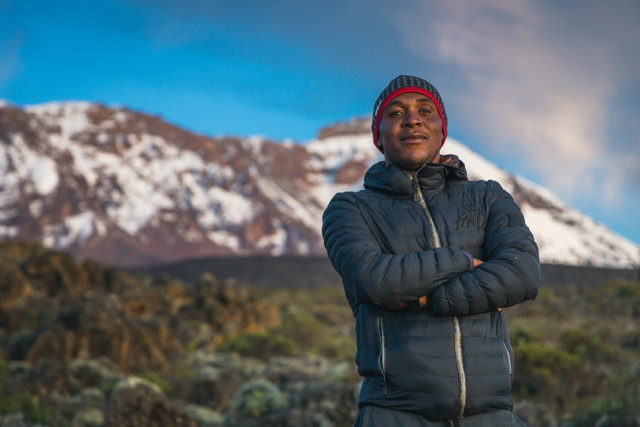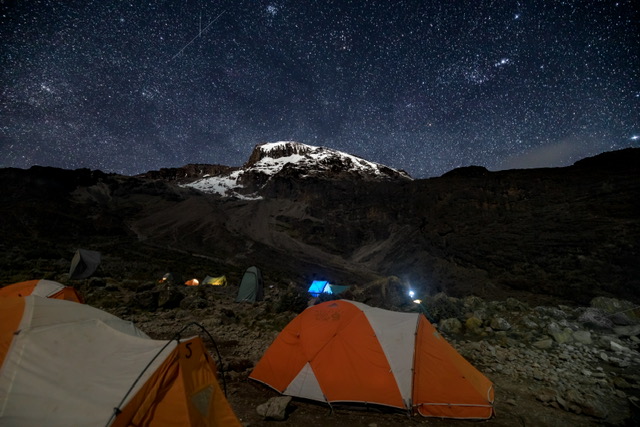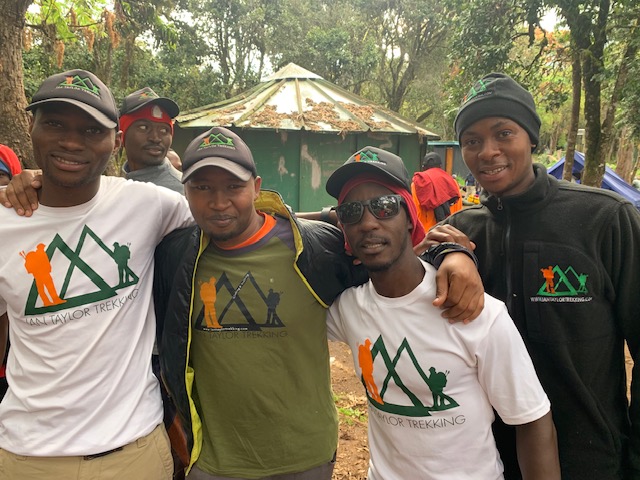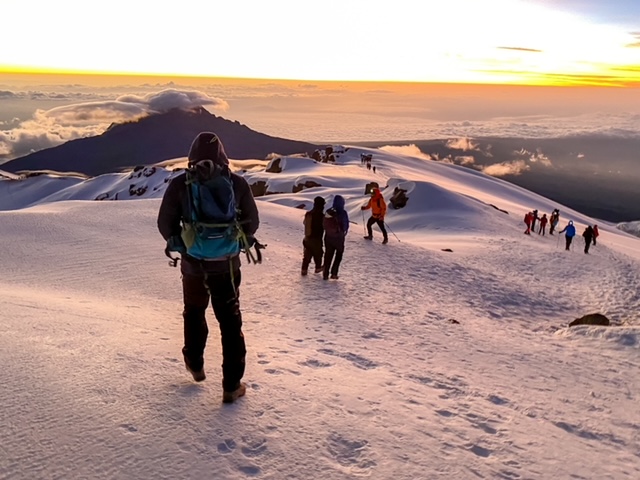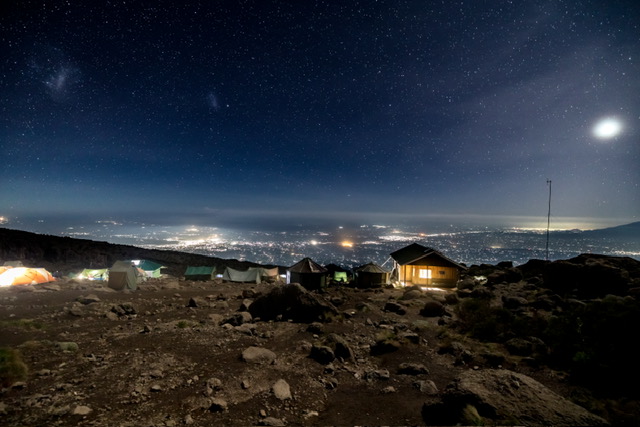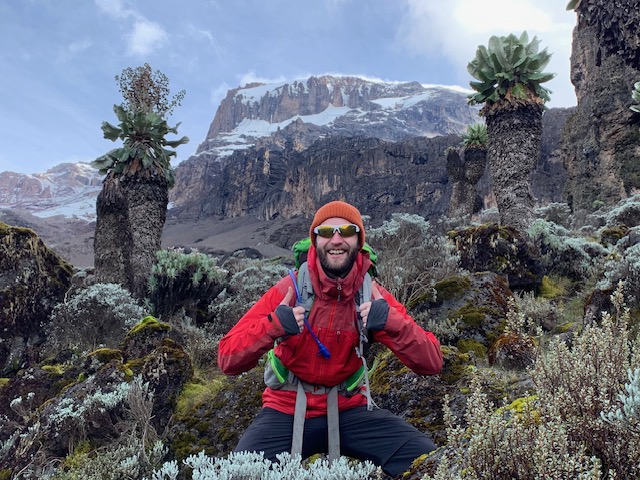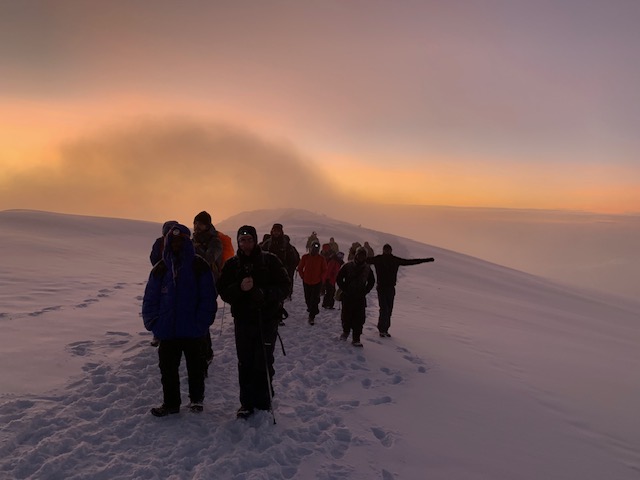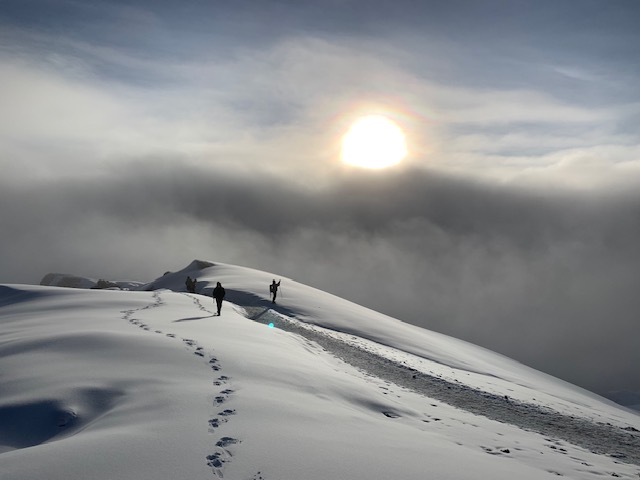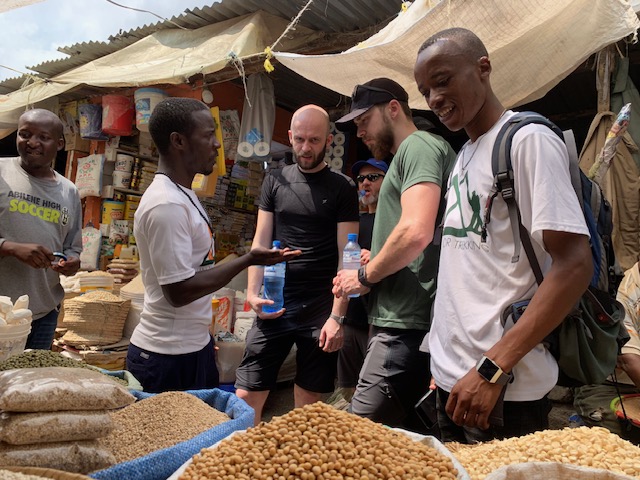Here are 20 things you need to know before climbing Kilimanjaro. After 17 years of climbing Kilimanjaro over 45 times I am here to share some inside information so you can get the most out of your Kilimanjaro climb. I have climbed Mount Everest 6 of the 7 summits and chat to chat with you and share the lessons I have learned climbing Kilimanjaro. Contact me and check out all our upcoming trips.
Kilimanjaro Tours
Mount Kilimanjaro does not require any technical skills. There is no need for mountaineering equipment because there is no danger of falling off a cliff or into a crevasse. Furthermore, there are is only one parts of the trail that requires scrambling and you can skip this section if you like the Rongai or Northern Circuit routes.
More than 30,000 people attempt Kilimanjaro every year with an overall success rate of 60% of people making the summit. Choosing the right route and adequately preparing for the climb are paramount when embarking on a Kilimanjaro expedition. The demographics of those visitors show that people from all walks of life come here to test their mettle. However, regardless of your background or experience level, selecting a suitable route that aligns with your capabilities and undergoing proper training are essential steps towards a safe and successful ascent. Climb with Kilimanjaro’s number one guide.
1). Acclimatization is Everything
Unless you live and train at high altitude you would only consider a trek with a minimum of 7 days. We prefer 8 days on Kilimanjaro. Altitude sickness, also known as acute mountain sickness (AMS), occurs when the body fails to acclimatize to the decreasing oxygen levels at higher elevations.
It can lead to symptoms such as headache, nausea, dizziness, and fatigue. To minimize the risk, climbers should follow a gradual ascent schedule, allowing time for their bodies to adjust to the altitude. On Kilimanjaro the Lemosho route and Northern circuit route are optimized for this.
2). Choosing the Right Route is Essential
Choosing the right route is essential for safety, success and experience on the mountain. Kilimanjaro offers several routes of varying lengths, difficulty levels, and scenic attractions. The most popular routes include the Marangu, Machame, Lemosho, and Rongai routes, each with its own advantages and challenges. I personally don’t like the Marangu route for a Kilimanjaro climb.
Factors to consider when choosing a route include the length of the trek, accommodation options, altitude profile, and scenery. From our extensive research hiking on each route up Kilimanjaro I can tell you that we recommend 3 routes and one in particular. Hands down the Lemosho route over 8 days using Kosovo Camp as High Camp is the best overall experience for climbing Kilimanjaro. We also like the Machame route and the Northern route.
3). Weather on Kilimanjaro can be Unpredictable
Be prepared for sudden changes and varying conditions. The weather on Kilimanjaro can be unpredictable, despite its proximity to the equator, Kilimanjaro’s high altitude results in diverse microclimates and weather patterns. Conditions can change rapidly, from clear skies and warm temperatures to cold winds and snowfall.
It’s essential to pack and dress accordingly, with layers that can be added or removed as needed. Waterproof and windproof outer layers are advisable, along with insulated clothing for colder temperatures at higher elevations. Additionally, be prepared for intense sun exposure during the day, as UV radiation is stronger at altitude.
4). Training for the Ascent
Training is required to ascend Kilimanjaro safely. Firstly, remember that you train to you can get up and have plenty in reserve for the downhill. Kilimanjaro has a big descent. Secondly, we need to training correct for the ascent so that you can enjoy this life changing experience. Far too many people, in fact, most people are underestimating Climbing Kilimanjaro.
Kilimanjaro requires a certain level of physical conditioning and strength. Fitness, in terms of can I run a marathon in 3 hour 30 really plays a little part of being able to hike up and down hills with a backpack for 8 days in a row. Endurance training, including cardiovascular exercises like hiking, running, or cycling, can help prepare your body for the long and strenuous trek. Strength training, especially focusing on leg muscles, is also beneficial for carrying gear and navigating challenging terrain. Learn more.
5). Training for the Descent
Many accidents happen on the way down due to fatigue and carelessness. Importantly, you need to do a lot of training for the downhill. While much emphasis is placed on ascending Kilimanjaro, the descent can be equally taxing on the body. A lot of people who summit Kilimanjaro have to relay on guides to carry their bags and even themselves. Don’t be one of these people.
Downhill hiking places significant strain on the knees and leg muscles. To prepare, incorporate downhill training into your regimen, such as practicing descents on steep terrain or using a stair climber machine. Strengthening exercises for the quadriceps and calves can also help reduce soreness and prevent injury during the descent.
6) Packing Strategically is Key
Only bring essentials and keep your pack as light as possible. Think of the porters who will have to carry all your gear up and down the mountain. There are some essentials you can not compromise on as you need the correct sleeping bag, layers, trekking boots and gloves. Watch our packing videos for further advice.
Packing strategically is key: When preparing for a Kilimanjaro climb, packing light and efficiently is essential for comfort and mobility on the trail. While it’s tempting to bring along a multitude of gear and clothing options, excess weight can slow you down and increase fatigue. Bring the correct down jacket.
Focus on essentials such as clothing layers, a sturdy backpack, a sleeping bag rated to 0F, a headlamp, hydration system, snacks, and personal items. If you sign up for one of our trips we send you a 40 page dossier with itemized kit list.
7). Hiring a Reputable Guide Service
Hiring a reputable guide service is highly recommended. Kilimanjaro is best climbed with the assistance of experienced guides. Our head guide was voted Kilimanjaro’s Number 1 Guide in 2019.
The guides need to be strong enough to manage the safety of each person. Far too many guides are allowing underprepared hikers high on the mountain. The guides need to familiar with weather conditions, and safety protocols. A reputable guide service will provide knowledgeable guides, porters to carry gear, and support staff to ensure a safe and enjoyable trek.
Repeatable companies will cover insurance and medical for their staff, pay appropriate wages and invest in the staff. We have sent over 20 staff to college to learn English, become chefs and guides. Read some reviews.
8). Proper Hydration is Critical at High Altitudes
Proper hydration is critical at high altitudes: Staying hydrated is essential for maintaining energy levels, preventing altitude sickness, and aiding acclimatization during your Kilimanjaro climb. However, the dry air and increased respiratory rate at altitude can lead to greater fluid loss through breathing and sweat. Read more.
It’s recommended to drink 4 liters of water per day while on the mountain, including during meals and breaks. Hydration systems such as hydration bladders or water bottles with insulating sleeves are convenient for easy access to water while hiking. Additionally, consider electrolyte supplements or sports drinks to replenish essential minerals lost through sweat.
9). Nutrition Plays a Vital Role in Your Success
Nutrition plays a vital role in your success: Fueling your body with the right nutrients is crucial for sustaining energy levels and supporting recovery during your Kilimanjaro climb. This why we only provide the highest quality of food on our Kilimanjaro trips.
Aim for a balanced diet rich in carbohydrates, proteins, healthy fats, fruits, and vegetables. High-energy snacks such as nuts, dried fruits, energy bars, and chocolate are excellent for quick boosts of energy on the trail. We also recommend nutritional supplements, you will find the list in our trip dossier.
Pack lightweight and calorie-dense snacks if you know if need to eat more regularly while on the trail.
10). Rest is Just as Important as the Climb Itself
Rest is just as important as the climb itself: Adequate rest and recovery are essential for optimizing performance and reducing the risk of injury and fatigue during your Kilimanjaro climb. While it’s natural to push yourself to reach the summit, it’s equally important to listen to your body and prioritize rest when needed.
Incorporate rest days into your itinerary to allow your muscles to recover and your body to acclimatize to the altitude. During rest breaks on the trail, take off your boots, elevate your feet, and hydrate and refuel your body. Quality sleep is also critical for physical and mental well-being, so ensure you have a comfortable sleeping setup and practice good sleep hygiene throughout your expedition.
11). Mental Preparedness is Essential
Stay positive, focused, and determined throughout the journey. Mental preparedness is essential to be successful climbing Kilimanjaro. A lot of your mental readiness comes from all the preparation and previous experience. The summit night on Kilimanjaro is just as much a mental challenge as it is a physical one.
Mental toughness, positive thinking, and determination are essential for overcoming obstacles, pushing through discomfort, and staying focused on your goal of reaching the summit.
Visualize success, break the journey into smaller, manageable tasks, and celebrate each milestone along the way. Develop coping strategies for dealing with challenges such as fatigue, altitude sickness, and adverse weather conditions. Surround yourself with supportive teammates, guides, and fellow climbers who can provide encouragement and motivation when needed.
By cultivating a resilient mindset and embracing the adventure with an open heart and mind, you’ll increase your chances of success and create lasting memories of your Kilimanjaro climb.
12). Layering
Layering clothing is the best approach for managing temperature changes on Kilimanjaro. Kilimanjaro’s diverse microclimates and fluctuating weather conditions require versatile clothing options that can adapt to changing temperatures and conditions throughout the day.
Layering is the most effective strategy for regulating body temperature and staying comfortable while hiking. Start with a moisture-wicking base layer and T-shirts. Merino is best! Picking layers that draws sweat away from the skin to keep you dry and comfortable.
Add insulating layers such as a down vest, fleece or Synthetic jacket like the Patagonia nano jacket. You also need the correct down jacket for warmth high on the mountain. Bring waterproof and windproof outer shell to protect against rain, snow, and wind. Opting for clothing made from lightweight material and ethical brands.
13). Invest in Quality Gear, Especially Footwear
Comfortable and durable trekking boots are a must. Here are the trekking boots we recommend. They don’t have to be these boots, but they need to be similar for warmth and ankle support.
We have some high quality items to rent, such as duffle bags, Thermarest Luxury map air mattresses, down sleeping bags, Trekking poles and some down jackets.
14). Symptoms of Altitude-Related illnesses
Altitude sickness can affect anyone, regardless of fitness level. One common misconception is that only unfit individuals are susceptible to altitude sickness. However, even the fittest climbers if they ascend to quickly can experience symptoms.
It’s essential to recognize the signs of AMS, which can range from mild discomfort to life-threatening conditions like high altitude pulmonary edema (HAPE) and high altitude cerebral edema (HACE). Symptoms typically appear above 2,500m/ 8,200 feet and can worsen with continued ascent. Adequate acclimatization, hydration, and awareness of your body’s signals are crucial for managing altitude sickness.
Ensuring your safety on Kilimanjaro involves regular monitoring of your oxygen levels and lung condition by your guide, typically twice a day, to detect any signs of altitude sickness. Some climbers opt for Diamox, a medication that may alleviate symptoms like headaches and shortness of breath.
It’s essential to obtain Diamox from your home country under a doctor’s guidance. If you experience dizziness, fatigue, loss of appetite, headache, or sleep disturbances, notify your guide immediately, as these could indicate altitude sickness. While some symptoms may result from physical exertion, others might signify a developing altitude-related issue.
15). Respect the Guides
We have trained our guides to turn people around who can not keep our minimum pace. Our minimum pace is designed to make sure each person can safely reach the summit and get back down safely.
If your guide instructs you to return down the mountain it is critical to listen, and follow their instructions. Summits over safety will not be tolerated in any way shape or form.
16). Respect the Mountain and its Environment
Far too many people are leave toilet paper all over the mountain. Bring Composable bags and carry it with you to the next camp. Practice Leave No Trace principles and preserve Kilimanjaro’s beauty. Try and bring recyclables materials back home with you as they will be burning if left in country. On top of this you should consider offsetting your carbon for this trip.
17). Sleeping on Kilimanjaro
Sleeping on Kilimanjaro and above 2,500m/ 8,200 feet can be challenging, but important for recovery and moving higher. Sleep is an important part of the acclimatization process.
Sleeping at high altitude presents challenges for many trekkers on Kilimanjaro. Hypoxia, or low oxygen levels, directly impacts the brain’s sleep center, leading to frequent awakenings, light and non-restful sleep, and reduced total sleep time. Even individuals accustomed to mountain environments may struggle with sleep disturbances despite acclimatization efforts.
You can consider Diamox, alternatives to Diamox and consider taking 400mg of Ibuprofen to aid sleep above 3,658m/ 12,000 feet.
18). Getting to Kilimanjaro
Getting to Kilimanjaro is pretty straight forward and you have two main options. Firstly, the airport you need to fly into is Kilimanjaro International Airport (JRO). Secondly, you have two main options via Qatar Airways or KLM. Thirdly, there are other flight options and you can review them in skyscanner. I personally like to pick a main carrier and arrive a day early in case there are any baggage delays.
19). Limited Access to Cell and WiFi
A new WiFi option has been activated on Kilimanjaro as of March 2024. The best option for 3G and 4G coverage is to get an Esim on arrival. There is a Vodacom store in Arusha and easy to activate cell coverage and get credit for your time on Kilimanjaro.
20). Join us on Safari
We have our own Safari vehicle available to you after your Kilimanjaro climb. We can send you our 5 most popular safari options so you can review which one you would like to join before coming to Tanzania.
We like to use the Ngorongoro Farmhouse for our safari’s and we highly recommend visiting the Serengeti, Tarangire and the most impressive Ngorongoro crater as part of any safari in Tanzania. Contact us today and learn from our experience.

